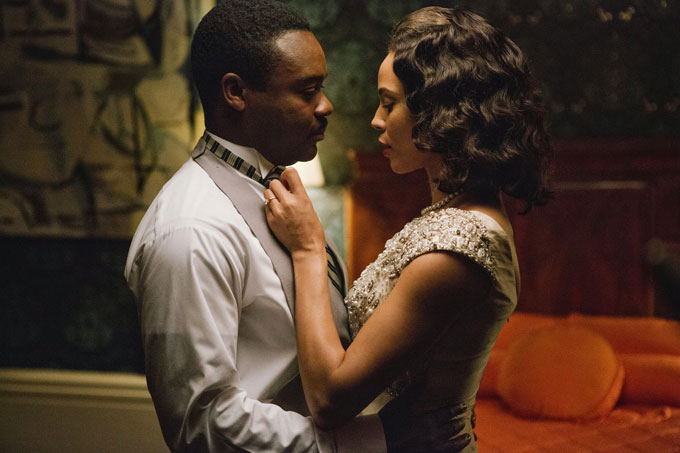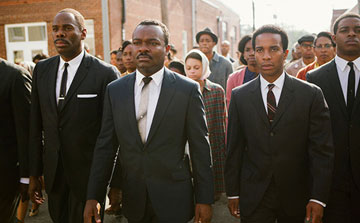Selma
by Jordan Canahai

The word biopic has become something of a dreaded word amongst film buffs in recent years, signifying something that need be approached with caution, especially when it comes to tackling towering historical figures. This is understandable, of course, after countless based-on-true-events movies that resonate less as cinematic renderings of history and human stories than shiny award season bait. Ava DuVernay’s Selma, which takes as its subject none other than Martin Luther King, Jr., the leading American humanitarian activist of the twentieth century, especially invites instant caution and doubt. It’s risky to tread such sacred ground, the accomplishments of this great man are so clear, documented, and hard to overstate, how can filmmaker’s dramatize his life without it feeling shallow and hackneyed? Thankfully, DuVernay and screenwriter Paul Webb so smartly and successfully avoid such pitfalls with Selma that one feels an almost constant sense of relieved excitement while watching it.
Bringing to mind Steven Spielberg’s Lincoln in the way it examines the life of its subject by focusing acutely on one turbulent episode in history and the practical matters of how, not just why, he pushed for and instituted political change, Selma is more procedural than biopic, though it also functions as a nuanced human portrait. In the film’s prologue our first image is of a nervous King (David Oyelowo) rehearsing in front of a mirror his acceptance speech for the Nobel Peace Prize in October 1964, with the reassurance of his wife, Coretta Scott King (Carmen Ejogo). This moment establishes a tone of quiet intimacy in a film that’s about the importance of grand gestures, while allowing us to empathize with the man who is in the process of changing the world while still finding the right words to do so.

From here Selma’s narrative charts in detail how King and his associates, fellow Southern Christian Leadership Conference members as well as cofounder’s of the Student Nonviolent Coordinating Committee, struggle to organize and carry out non-violent protests in Selma, Alabama, a region notorious for its systematic disenfranchisement of black voters. Their efforts eventually led to President Johnson (Tom Wilkinson) passing the Voting Rights Act of 1965, thus making this event an ideal choice for the film, and a relevant one, considering the continued disenfranchisement of black and minority voters in our country today. The film effectively dramatizes the racist and unjust methods by which African-Americans were kept from voting in an early scene set in the county clerk’s office depicting the failed registration efforts of Selma resident Annie Lee Cooper (Oprah Winfrey, cast against type in a fragile supporting role). Her painful experience is one endured by far too many, and the film’s power comes from the way in which it makes such seemingly small, personal moments sync with the larger narrative, stoking our desire for both justice and drama. When King arrives in Selma, against the pragmatic recommendation of his sometimes-ally President Johnson, we are just as ready for the inevitable march towards righteous change because history, not the narrative, demands it. DuVernay imbues the film with alternating movements of anger and assured calm for maximum dramatic effect.
As mentioned before, Selma functions both as procedural and character study, though while the historical narrative plays out in literal, detailed fashion, King’s personal story is perhaps the more abstract one, as it aspires to move viewers towards a better understanding of the man not simply through dry, History channel-esque characterizations but by allowing us to observe him in close proximity. With his spot-on vocal cadences and vulnerable empathy, Oyelowo makes this proximity gratifying and intensely moving, while DuVernay and cinematographer Bradford Young find just the right visual touches for telling his story. Their striking use of natural lighting, effective in both the film’s interior moments as well as its large-scale crowd scenes, gives the picture a wonderful, sun-kissed look, while their elegant use of profile shots, especially of King, not only highlights Oyelowo’s brilliant, nuanced performance, but more importantly gives the sense that King is looking out on the world rather than that we are simply looking up at him. The film is not about further idolizing MLK, but about better understanding how he witnessed the world, and figured out how through political maneuvering he could make it a more human one.
Selma, like the best procedurals, has a satisfying cause-and-effect structure, but it never expects us to take it as simple entertainment; not only because of its harrowing portrayal of the violence protestors endured at the hands of police on horseback, who wield attack dogs, billy clubs, and tear gas with extreme prejudice (like last year’s 12 Years a Slave, the horrors of racism are captured here in uncomfortably painful, realistic fashion), but also because the film asks deeply for our utmost thoughts and attention. Selma is not meant to make us feel as though the struggles of the past are simply in the past, but at the same time the film is also too sophisticated to be a simple “message movie” or vague call to action. It’s about the tides of history; and the wonder, excitement, and fear of being caught up in them.
Watch the trailer for Selma
|
Issue Navigation> Issue Index > v14n2 (Week of Thursday, January 15) > Selma This Week's Issue • Artvoice Daily • Artvoice TV • Events Calendar • Classifieds |









 Current Issue
Current Issue